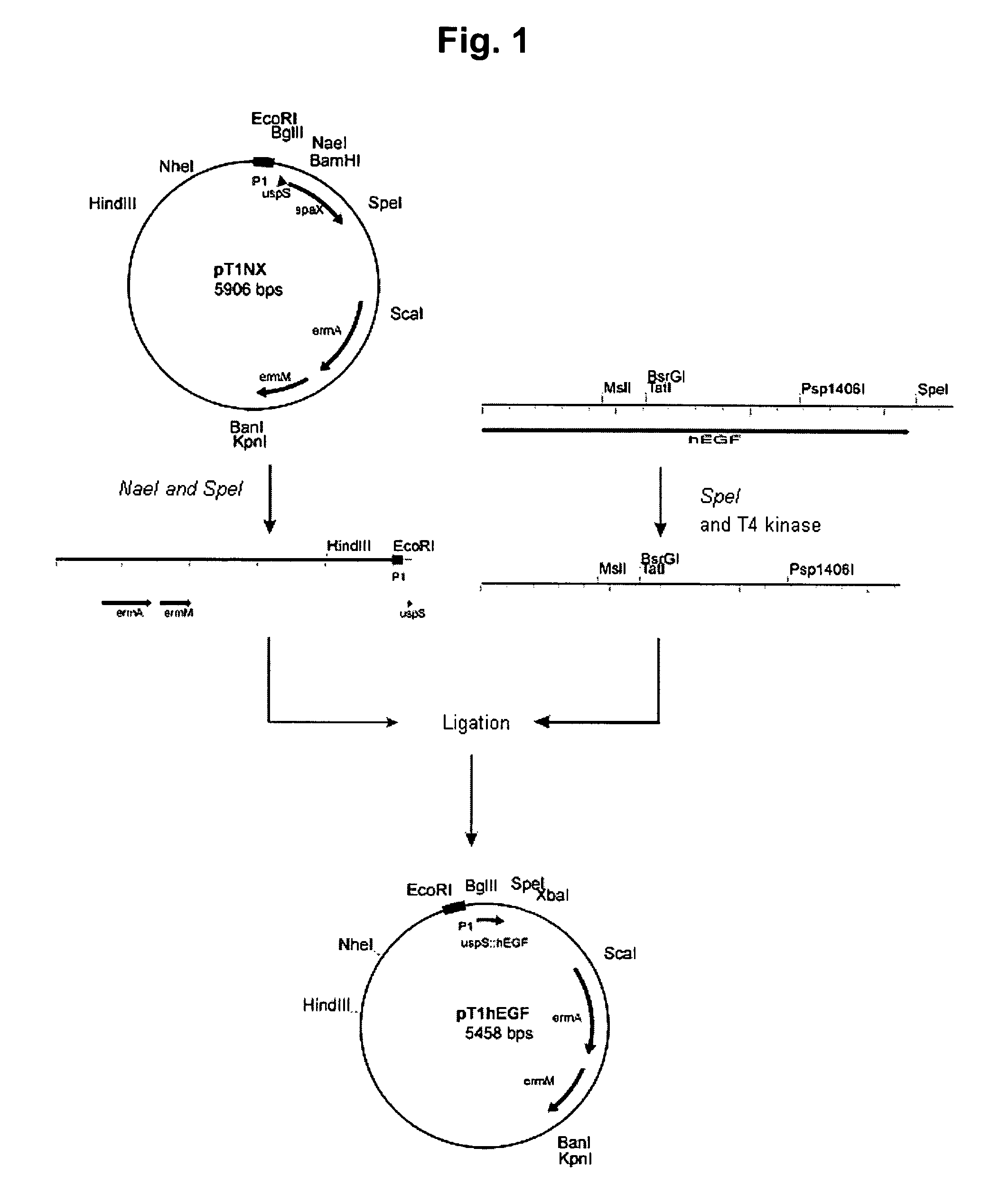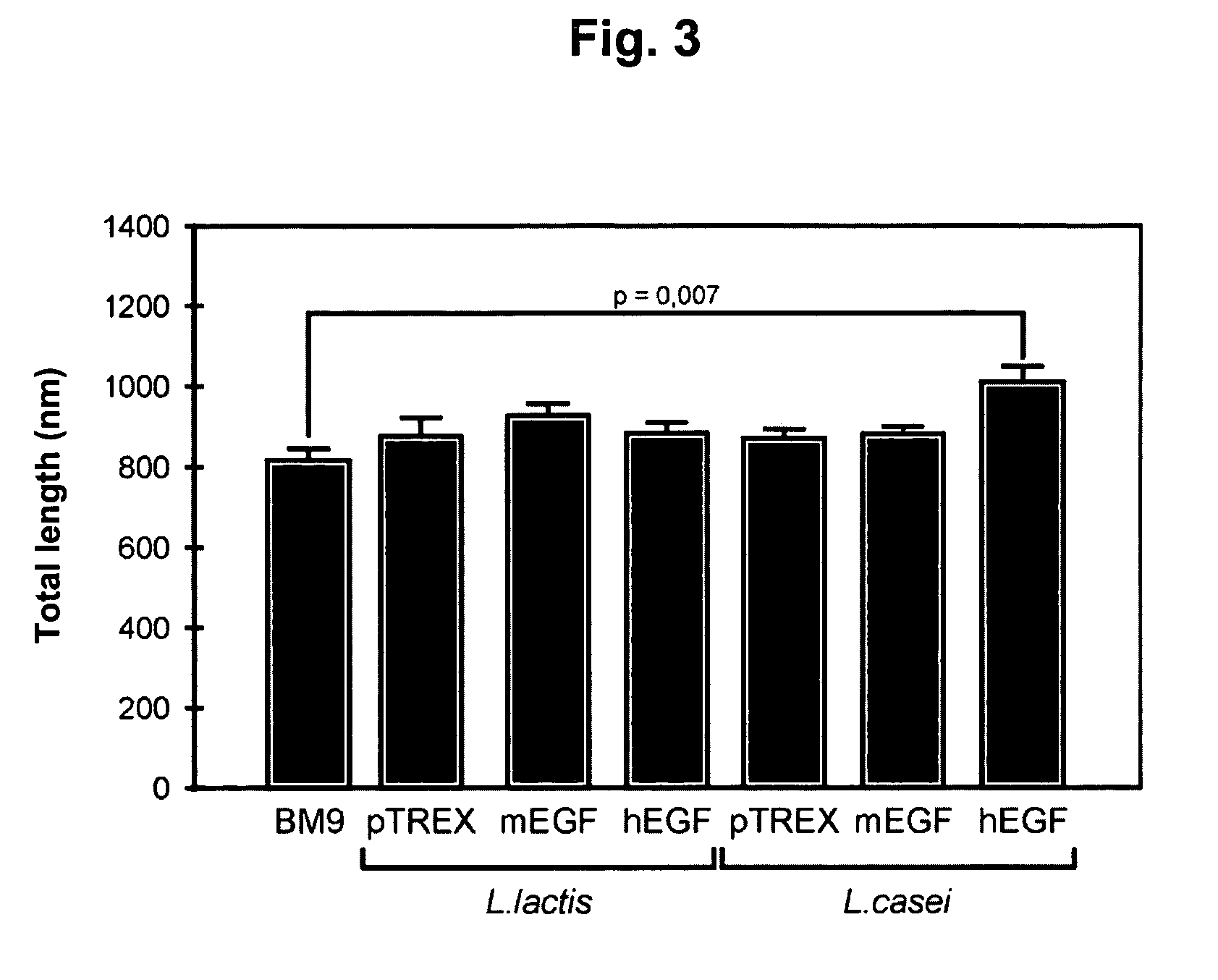Methods and means to promote gut absorption
a technology of lactic acid bacteria and growth factor, applied in the field of biotechnology, can solve the problem that the lactic acid bacteria cannot be predicted to survive sufficiently, and achieve the effect of enhancing the positive effect of egf and positive effect on gut absorption
- Summary
- Abstract
- Description
- Claims
- Application Information
AI Technical Summary
Benefits of technology
Problems solved by technology
Method used
Image
Examples
example 1
Optimizing the EGF Coding Sequence for Expression in Lactococcus
[0046]Both the murine as well as the human EGF (accession number X04571 for hEGF and NM 010113 for mEGF) are available in the public databases at the National Center for Biotechnology Information (accession number X04571 for hEGF and NM—010113 for mEGF). The coding sequences were adapted to optimize the expression in Lactococcus. On the base of these sequences, primer sets were designed to assemble the optimized coding sequences of both hEGF and mEGF. At the 3′ end of the coding sequence, a SpeI restriction site was introduced. The primers are shown in Table 1 (hEGF) and Table 2 (m EGF).
[0047]
TABLE 1oligos used for assembly of hEGF, and the amount availableSenseHEGF01AACTCAGATTCAGAATGTCCACTTTCACACGATGGTTACT33.3 nmol(SEQ ID NO:5)HEGF02GTTTGCACGATGGTGTTTGTATGTACATCGAAGCTCTTGA34.8 nmol(SEQ ID NO:6)HEGF03TAAATACGCTTGTAACTGTGTTGTTGGTTACATCGGTGAA26.9 nmol(SEQ ID NO:7)HEGF04CGTTGTCAATACCGTGATTTGAAATGGTGGGAACTTCGTT28.8 nmol(SE...
example 2
Construction of pT1hEGF and pT1mEGF and transformation into Lactococcus lactis
[0053]SpeI cut assembled EGF (both for hEGF and mEGF) is ligated into a NaeI and SpeI digested pT1NX (Steidler et al., 1995), resulting in pT1hEGF and pT1mEGF. A schematic overview of the construction of pT1hEGF is shown in FIG. 1. Plasmids are transformed into competent cells of L. lactis by electroporation. 50 μl of cells are electroporated in a precooled cuvet of 2 mm, at 25 μF, 2.5 kV and 400 Ω (Bio-Rad electroporator). L. lactis is made competent by growing a 1 / 100 dilution of a saturated culture, in 200 ml GM17 with 2.5% glycine, until an OD600 of 0.5 (Wells et al., 1993). After electroporation, 1 ml of recuperation medium is added, and the cells are incubated for 1.5 hour at 28° C. Cells are plated on GM17 solid medium, comprising 5 μg / ml erythromycin.
[0054]For the transformation of L. casei, plasmid is isolated from L. lactis on a Qiagen-tip 100, according to the instructions of the manufacturer. ...
example 3
Expression of EGF in L. lactis and L. casei
[0055]The transformed L. lactis strains MG1363 [pT1NX], MG1363 [pT1mEGF] and MG1363 [pT1hEGF] are pitched in 5 ml GM17 comprising 5 μg / ml erythromycin, and grown overnight at 30° C. This preculture is diluted 1 / 100 in 5 ml GM17 with erythromycin, and incubated for three hours at 28° C. The culture is centrifuged and resuspended in BM9 expression medium, and incubated overnight at 28° C. The transformed L. casei strains are grown under similar conditions, but using MRS as preculture, and BM9 as expression medium.
[0056]To the culture supernatant, 1 / 10 volume sodium desoxycholate is added, and the mixture is kept on ice for 10 minutes. 1 / 10 of volume 100% TCA is added and the mixture is incubated on ice for 15 minutes. After centrifugation, the pellet is dissolved in 50 μl H2O and 50 μl 1 M Tris-HCl pH 9.5. The proteins are analyzed on a 20% Laemmli protein gel. Detection is carried out using a Western blot, with mouse polyclonal anti hEGF an...
PUM
| Property | Measurement | Unit |
|---|---|---|
| molecular weight | aaaaa | aaaaa |
| pH | aaaaa | aaaaa |
| pH | aaaaa | aaaaa |
Abstract
Description
Claims
Application Information
 Login to View More
Login to View More - R&D
- Intellectual Property
- Life Sciences
- Materials
- Tech Scout
- Unparalleled Data Quality
- Higher Quality Content
- 60% Fewer Hallucinations
Browse by: Latest US Patents, China's latest patents, Technical Efficacy Thesaurus, Application Domain, Technology Topic, Popular Technical Reports.
© 2025 PatSnap. All rights reserved.Legal|Privacy policy|Modern Slavery Act Transparency Statement|Sitemap|About US| Contact US: help@patsnap.com



